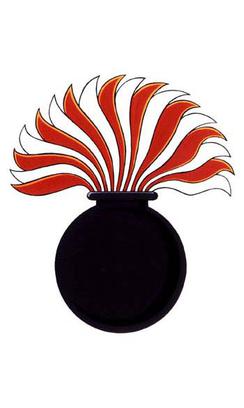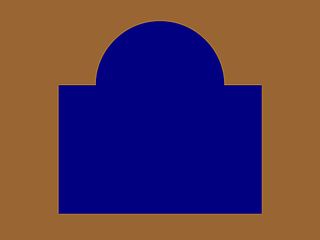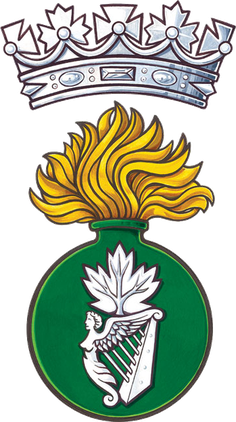
The North Saskatchewan Regiment is a Primary Reserve infantry regiment of the Canadian Army, headquartered in Saskatoon, Saskatchewan, with companies in Saskatoon and Prince Albert. Its current commanding officer is Lieutenant-Colonel Mike Graver, and the Regimental Sergeant-Major is Chief Warrant Officer Jason Balcaen. The N Sask R is part of the 3rd Canadian Division's 38 Canadian Brigade Group.
The 152nd Battalion, CEF, was a unit of the Canadian Expeditionary Force during the Great War. It was authorized on 22 December 1915, recruiting in Weyburn and Estevan, Saskatchewan, and embarked for Great Britain on 3 October 1916, where its personnel were absorbed by the 32nd Reserve Battalion, CEF, on 21 October 1916 to provide reinforcements for the Canadian Corps in the field. The battalion was disbanded on 21 May 1917.

The Winnipeg Grenadiers was an infantry regiment of the Canadian Army.

The Royal Regina Rifles is a Primary Reserve infantry regiment of the Canadian Army. Prior to 1982 the regiment was known as The Regina Rifle Regiment. The Royal Regina Rifles are part of 3rd Canadian Division's 38 Canadian Brigade Group.
The Prince Albert Volunteers (PAV) is the name of two historical infantry units headquartered in Prince Albert, Saskatchewan. The unit was first raised in 1885 during the North-West Rebellion and disbanded after hostilities ceased. In the 20th century, the unit was operational from 1913 to 1936 and 1941 to 1946. The PAV is now incorporated by amalgamation in the North Saskatchewan Regiment (N Sask R).

The Saskatchewan Dragoons is a Primary Reserve armoured regiment of the Canadian Army. The unit is based in Moose Jaw. Their primary job is to assist the Regular Force in meeting Canada's military commitments. Their training and equipment closely follow that of the Regular Force, which the Reserves are called upon to assist increasingly often. The Saskatchewan Dragoons are part of 3rd Canadian Division's 38 Canadian Brigade Group.

The 19th Alberta Dragoons was a cavalry regiment and later an armoured regiment of the Canadian Militia and later the Canadian Army. It was placed on the Supplementary Order of Battle in 1965. In 2006, it was taken off the Supplementary Order of Battle and amalgamated with the South Alberta Light Horse.
The 1st Battalion, Canadian Mounted Rifles, CEF, was an infantry battalion of the Canadian Army. Raised for service during the First World War as part of the Canadian Expeditionary Force (CEF), it was formed in November 1914, in Brandon, Manitoba. Originally a mounted infantry unit named the 1st Regiment, Canadian Mounted Rifles, CEF, which was expanded, following its rerolling and dismounting as an infantry unit, by absorbing other units of the Canadian Mounted Rifles (CMR).

The 5th Battalion, CEF, known as "Tuxford's Dandys," was an infantry battalion of the Canadian Expeditionary Force during the Great War.
The Canadian Fusiliers (City of London Regiment) was an infantry regiment of the Non-Permanent Active Militia of the Canadian Militia (now the Canadian Army). In 1954, the regiment was amalgamated with The Oxford Rifles to form The London and Oxford Fusiliers (now the reserve battalion of the Royal Canadian Regiment).

The 28th Battalion (Northwest), CEF was an infantry battalion of the Canadian Expeditionary Force during the Great War.

The Irish Fusiliers of Canada (The Vancouver Regiment) was an infantry regiment of the Canadian Army. It was placed on the Supplementary Order of Battle in 1965. In 2002, it was taken off the Supplementary Order of Battle and amalgamated with The British Columbia Regiment (Duke of Connaught's Own).

The 46th Battalion, CEF, was an infantry battalion of the Canadian Expeditionary Force during the Great War.
The 65th Battalion (Saskatchewan), CEF was an infantry battalion of the Canadian Expeditionary Force during the Great War. The 65th Battalion was authorized on 20 April 1915 and embarked for Great Britain on 18 June 1916. Its personnel were absorbed by the 44th Battalion (Manitoba), CEF, 46th Battalion, CEF, 54th Battalion (Kootenay), CEF and 72nd Battalion, CEF of the 4th Canadian Division on 30 June 1916. The battalion was disbanded on 12 October 1917.
The Saskatoon Light Infantry was an infantry regiment of the Non-Permanent Active Militia of the Canadian Militia. The regiment was formed in 1924, when The North Saskatchewan Regiment (1920–1924) was reorganized into four separate regiments. In 1955, the regiment was amalgamated with The Prince Albert and Battleford Volunteers to form The North Saskatchewan Regiment.
The 16th/22nd Saskatchewan Horse was a cavalry regiment of the Non-Permanent Active Militia of the Canadian Militia. The regiment was formed in 1936, when the 16th Canadian Light Horse was amalgamated with The Saskatchewan Mounted Rifles. After a number of changes, the regiment now forms part of The North Saskatchewan Regiment.
The Sherbrooke Regiment was a regiment of the Canadian Militia and later the Canadian Army Reserve that existed from 1866 to 1965. Originally an infantry regiment, during the Second World War the regiment helped form the 27th Armoured Regiment (The Sherbrooke Fusilier Regiment) which served as an armoured (tank) unit in the 2nd Canadian Armoured Brigade. In 1946, the regiment itself was converted to an armoured regiment was redesignated as The Sherbrooke Regiment (RCAC). In 1965, the regiment was amalgamated with the 7th/11th Hussars to form The Sherbrooke Hussars.
The Argyll Light Infantry was an infantry regiment of the Non-Permanent Active Militia of the Canadian Militia. In 1936, the regiment was converted from infantry to form one of the Canadian Army's first tank units, and then in 1946 was converted to anti-tank artillery. In 1954, the regiment was converted back to infantry and amalgamated along with The Midland Regiment into The Hastings and Prince Edward Regiment.
The North Saskatchewan Regiment was a short-lived infantry regiment of the Non-Permanent Active Militia of the Canadian Militia. In 1924, the regiment was reorganized and split up into 4 separate regiments.
The South Saskatchewan Regiment was a short-lived infantry regiment of the Non-Permanent Active Militia of the Canadian Militia. In 1924, the regiment was reorganized and split up into 5 separate regiments.








